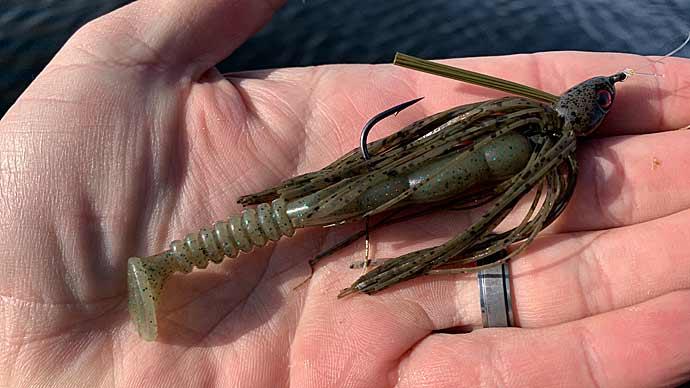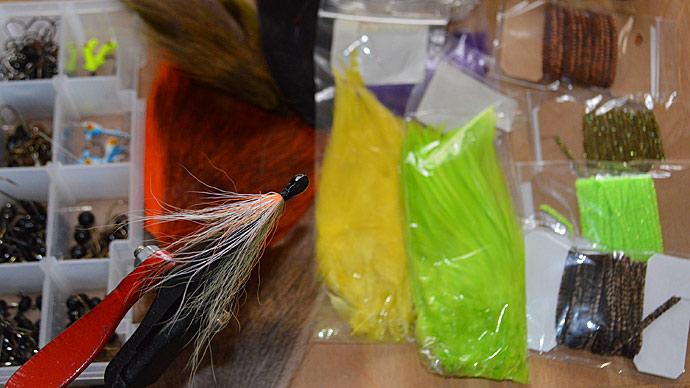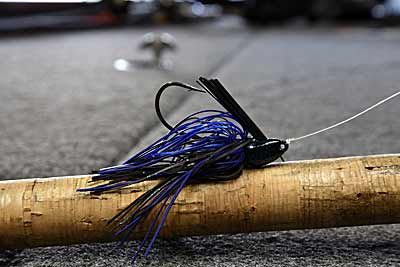
When you look at all the baits that we have to fish for bass, many stand out, and some have even gone through changes along the way. What started as rubber worms are now made of better and more durable plastic material. Another bait that started out being manufactured in a few different materials has now been transformed with different materials today. The bait that I'm referring to is the jig.
Looking back at the bass jig, it was first brought to fishing as a hair jig mainly made out of bucktail hair. After a successful run, it was then updated to a new material of that time, a rubber-legged jig. Years later, and in many cases, the rubber-legged jig surged to fast become the number one bass bait in many circles. There are still a few rubber skirted jigs in today's environment, but now dominant jigs of today are being made out of silicone skirt materials.
Silicone is a finer cut material than rubber, and this change gives your jig skirt more action. The other most significant improvement in today’s jigs is the rainbow of skirt colors to choose from. In the early days of rubber, you had about four or five colors to choose from, but today’s silicone material has close to a hundred different colors and patterns.
Let’s take a closer look at today’s bass jigs, and along the way, we will throw in a few jig patterns and tips on when to use specific jigs and colors in your bass fishing.
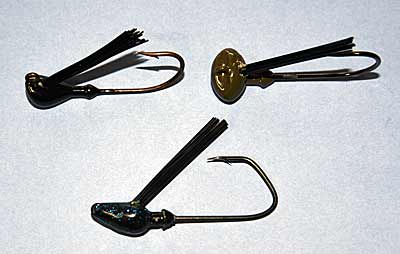
This article will highlight three styles of bass jigs that should be carried in your jig box.
Weed/Swim Jig Style
Cutting my bass teeth up in the north, I always have a weed jig tied on the end of my line as it's the number one jig that I throw day in and day out. It's a jig I have used for years and have a bunch of confidence in.
I make many weed jigs from a Do-It Mold (Bullet Bass Jig). I make my jigs for a few reasons. I can play with hook styles and sizes, and I can also adjust weed guards.
I'll also throw in jigs from Dirty Jigs into my mix. I'm a big fan of the No-Jack Swim Jig line up as these jigs can be fished as a weed jig or swim jig. They also have skirt colors that are dialed in like no others. Dirty Jigs are also equipped with X-Heavy Gamakatsu jig hooks. If a bass looks at this jig, they are hooked.
Weed Jig Equipment
When fishing a weed jig, I'll generally throw my jigs on a Denali Attax 7’2” MH baitcaster, teamed with a Lew’s BB-1 (6.2:1 gear ratio). I fill my reel with 15lb Sunline Assassin FC. This is a top-quality fluorocarbon that is priced right. If I'm fishing in windy conditions, I may switch to a reel spooled with 30lb Sunline Xplasma Asegai teamed with a 12lb-15lb FC leader. The switch to the braided line results in an improved feel from less stretch in the braided line.
When faced with bass dropping the bait before setting the hook, I'll switch to a 15lb mono leader to help with a bit of stretch factor. The added stretch often gives me a little cushion to keep the bass on the jig long enough to get a hook set.
Swim Jig Equipment
I'll use the same 7’2” Denali MH baitcaster for my weed jig presentation with the same Lew’s reel spooled with braid when it comes to swim jig equipment. One change, I'll shed the FC or mono leader. With the swim jig, you're moving the bait, and the bass don't get a good look at the jig before the bite, so I tie direct to the braided line to get a better hook set.
If I'm swim jig fishing in clear water conditions, I have been known to grab my weed jig rod equipped with fluorocarbon line to help get a few bites in tough conditions. I also have, in some cases, kept the braided line and added a fluorocarbon leader back into the mix.
Arky Jig Style
The second jig that I carry is an Arky-style jig head. I also have a mold for this jig from Do-It. If you're looking for a production jig, Dirty Jigs makes one that falls into their Signature Casting Jig series.
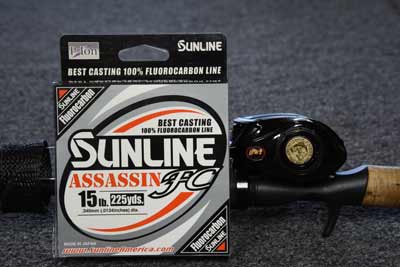
I use the Arky as kind of a jig of all trades. I can use it for fishing weeds. The wider head does an excellent job of getting through the weeds. This is also excellent for skipping jigs for dock fishing. The larger flat surface of the jig’s underside helps make it easy to skip.
I have also used the Arky-style jig as a football substitute for weeds mixed in with the rocks. The Arky head will get fouled less than a football head when you have patches of weeds in the rock areas. The less my jig gets fouled, the more productive I'll be in my day of fishing.
Arky Jig Equipment
I'll vary rod choices regarding Arky jig equipment according to my fishing situations. If I'm fishing the Arky jig in general weed conditions, I'll use the Denali Attax 7’2” MH baitcaster teamed with a Lew’s 6.2:1 reel spooled with Sunline 15lb Assassin FC.
I opt for a shorter rod if I'm skipping Arky jigs under docks. I turn to a 6’8” Denali Attax baitcaster teamed with a Lew’s BB-1 reel spooled with 15lb Sunline Assassin FC. The shorter rod lets me get the room. I need to get my jig angle closer to the water to skip jigs under docks, boat lifts, and walkways. One thing that I do is not to fill my reel all the way. I only fill the reel spool about 3/4 of the way to eliminate spool speed and backlashes.
In cases of when I fish the Arky jig as a football head, I'm a fan of a longer rod to get added casting distance and be able to pick up extra line when it comes to setting the hook. I'll opt to use a 7’3” – 7’6” MH rod. I team this with a Lew’s BB-1 6.2:1 reel filled with Sunline 15-20lb Assassin FC.
Football Jig
A football jig is a must-have fishing water with rock areas that hold good bass populations. The action and the feel you get from a football jig are valuable in breaking down key rock areas, allowing you to trigger bites in these areas.
Use your football jig as your depth finder. Make your cast and drag your football jig along the bottom. Try to get your jig up against every rock on the way back to the boat that you can. When you get your jig up next to a rock, rock your jig up and down a few times, getting it to stand up against the rock before you lift your rod tip to move it onto the next rock if you have not gotten a bite.
Football Jig Equipment
I'll use a 7’3” to 7’6” baitcaster with a Lew’s BB-1 6.2:1 reel filled with Sunline 15-20lb Assassin FC.
Trim Weed Guard & Sharpen Your Hook
When it comes to getting the most out of your jigs, you can do a few key things.
To start, you'll need to trim your weed guard. I have never picked up a jig that I have bought, and the weed guard was trimmed. The best way to do this is to cut your weed guard just past the hook point.
When the bass goes to bite down on the jig, the untrimmed weed guard can push the jig forward as the bass bites down. This could cause the jig to move forward enough to pull the jig out of the bass’ mouth when you set the hook.
A trimmed weed guard will result in more and better hookups. You want to trim your weed guard at the angle of the hook.
If you're fishing in thicker weeds, leave the weed guard a little longer. This will help keep your hook a little more weedless. But don't leave it so long that it interferes with your hook set.
When trimming your weed guard, check to see how sharp your hook is. If it doesn't catch your thumbnail surface as you drag it across your nail, you need to sharpen your hook. Look at it this way; if your jig is doing what it's supposed to do, you'll be hooking bass in the upper part of their mouth. This is the hard part of the mouth, and every time you're driving a hook into this area, you're dulling your hook. So, it's vital to check your hook point to make sure you have a straight hook point and a sharp hook.
Skirt Selection & Rattles
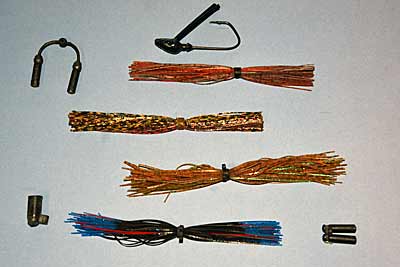
One of the first things that I do when fishing a jig after selecting what head style I'll use is pick a skirt to put on my jig. I rarely carry jigs that already have skirts because of the weight factor. I carry a few different jig heads and a wide assortment of skirts to team with my jig head to match the conditions that I'm fishing in.
I keep my skirt selection stocked with colors that imitate the forage in the waters in my area. Living in the Midwest, a bluegill skirt is the number one choice, with crawfish a close second. I'll also carry attraction colors, bluegill, and crawfish skirts with bright accent strands (red, chartreuse, and orange).
I use skirt collars to make my skirts add rattles. I use the following points to determine if I'll add rattles or not.
If fishing in dirty water conditions, I always add rattles to help the bass find my jig, like fishing in weeds on transparent water bodies. If the bass can't see my jig from a short distance, I have to help them find my jig and a rattle is one of the best ways to do that. I'll also add rattles when fishing crawfish-colored skirts to help imitate the sound that crawfish put off with their claws.
Trailers Options
Pay attention to your trailer picks, as this can be one of the most critical parts in getting bites on your jig. You have to pay attention to a few key things when picking a trailer to assist in attracting your jig.
First, what jig presentation are you fishing? If you're fishing a swim jig, you'll probably choose a trailer that will give your jig a lot of action, like a swimbait or grub. If you're fishing a football jig, you'll want to imitate a craw, so using a craw imitation will be a logical choice.
Pick trailers that enhance your jig’s action and add attraction colors as well. You can do this by choosing the color of the trailer or adding color accents and scents to the bait by using a colored dye.
I hope these jig tactics laid out will help improve your jig fishing and put more bass in your boat. Jigs are probably one of the most versatile baits that you have a chance to use, and at the same time, have a full accommodation of choices available to suit most conditions.
BassResource may receive a portion of revenues if you purchase using a link above.


